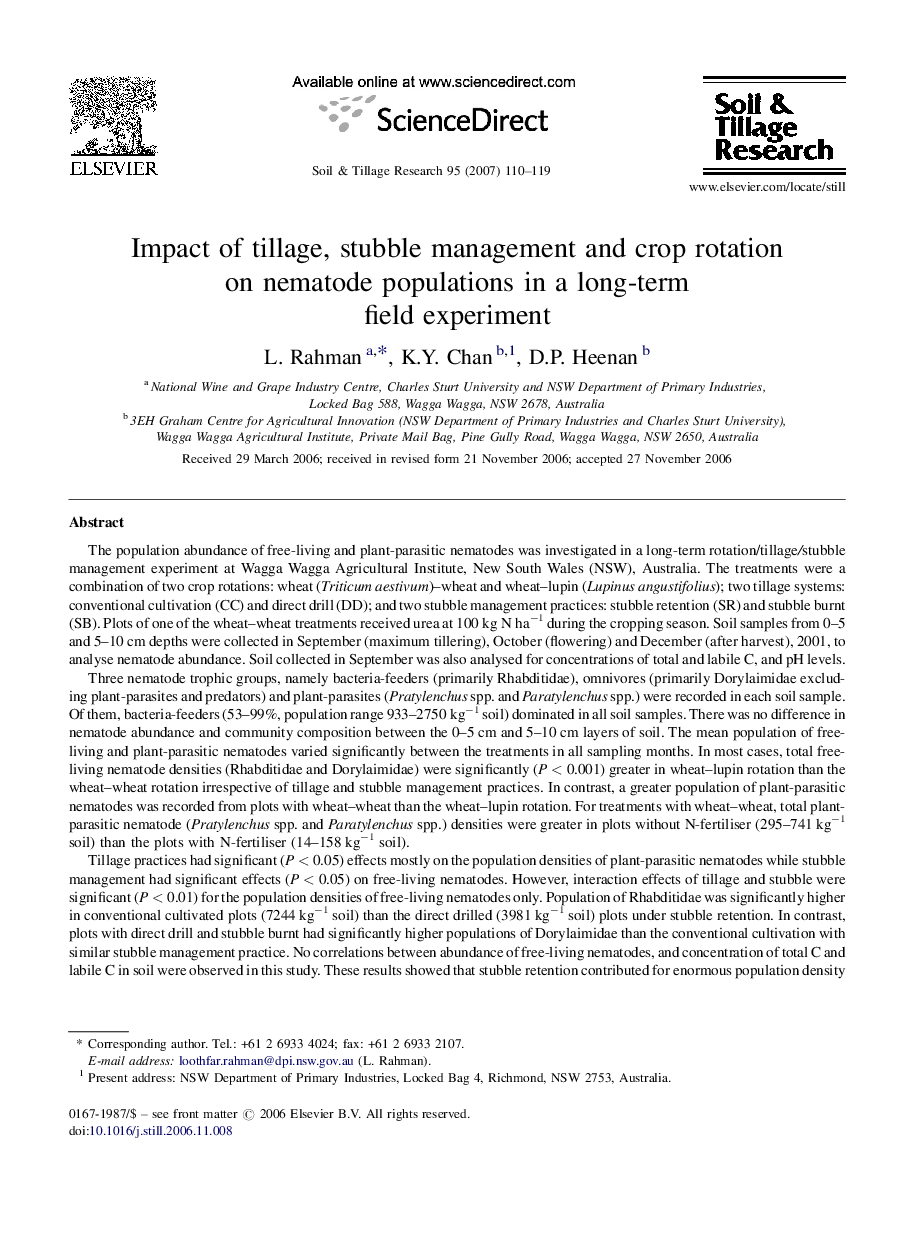| کد مقاله | کد نشریه | سال انتشار | مقاله انگلیسی | نسخه تمام متن |
|---|---|---|---|---|
| 306684 | 513109 | 2007 | 10 صفحه PDF | دانلود رایگان |

The population abundance of free-living and plant-parasitic nematodes was investigated in a long-term rotation/tillage/stubble management experiment at Wagga Wagga Agricultural Institute, New South Wales (NSW), Australia. The treatments were a combination of two crop rotations: wheat (Triticum aestivum)–wheat and wheat–lupin (Lupinus angustifolius); two tillage systems: conventional cultivation (CC) and direct drill (DD); and two stubble management practices: stubble retention (SR) and stubble burnt (SB). Plots of one of the wheat–wheat treatments received urea at 100 kg N ha−1 during the cropping season. Soil samples from 0–5 and 5–10 cm depths were collected in September (maximum tillering), October (flowering) and December (after harvest), 2001, to analyse nematode abundance. Soil collected in September was also analysed for concentrations of total and labile C, and pH levels.Three nematode trophic groups, namely bacteria-feeders (primarily Rhabditidae), omnivores (primarily Dorylaimidae excluding plant-parasites and predators) and plant-parasites (Pratylenchus spp. and Paratylenchus spp.) were recorded in each soil sample. Of them, bacteria-feeders (53–99%, population range 933–2750 kg−1 soil) dominated in all soil samples. There was no difference in nematode abundance and community composition between the 0–5 cm and 5–10 cm layers of soil. The mean population of free-living and plant-parasitic nematodes varied significantly between the treatments in all sampling months. In most cases, total free-living nematode densities (Rhabditidae and Dorylaimidae) were significantly (P < 0.001) greater in wheat–lupin rotation than the wheat–wheat rotation irrespective of tillage and stubble management practices. In contrast, a greater population of plant-parasitic nematodes was recorded from plots with wheat–wheat than the wheat–lupin rotation. For treatments with wheat–wheat, total plant-parasitic nematode (Pratylenchus spp. and Paratylenchus spp.) densities were greater in plots without N-fertiliser (295–741 kg−1 soil) than the plots with N-fertiliser (14–158 kg−1 soil).Tillage practices had significant (P < 0.05) effects mostly on the population densities of plant-parasitic nematodes while stubble management had significant effects (P < 0.05) on free-living nematodes. However, interaction effects of tillage and stubble were significant (P < 0.01) for the population densities of free-living nematodes only. Population of Rhabditidae was significantly higher in conventional cultivated plots (7244 kg−1 soil) than the direct drilled (3981 kg−1 soil) plots under stubble retention. In contrast, plots with direct drill and stubble burnt had significantly higher populations of Dorylaimidae than the conventional cultivation with similar stubble management practice. No correlations between abundance of free-living nematodes, and concentration of total C and labile C in soil were observed in this study. These results showed that stubble retention contributed for enormous population density of free-living (beneficial) nematodes while conventional cultivation, irrespective of stubble management, contributed for suppressing plant-parasitic nematodes.
Journal: Soil and Tillage Research - Volume 95, Issues 1–2, September 2007, Pages 110–119